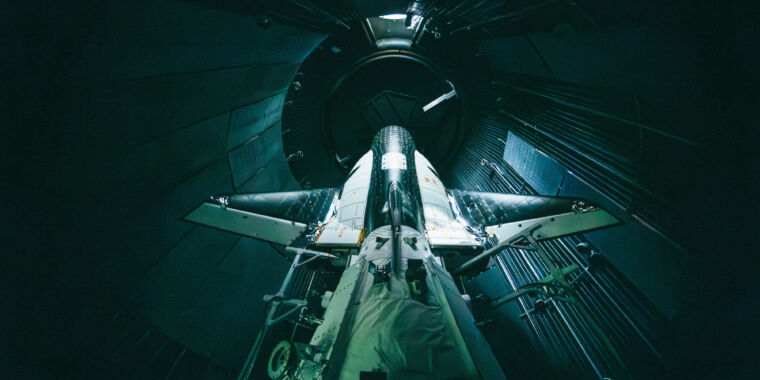
Space Sierra
There’s still some work to be done to prepare Sierra Space’s Dream Chaser spaceplane for its first mission, but the company says the International Space Station’s winged resupply vehicle will soon be shipped to its launch site in Florida.
The Dream Chaser will lift off aboard a United Launch Alliance Vulcan rocket to head to the space station. A Sierra Space spokesperson told Ars that the spaceplane is scheduled to launch in the third or fourth quarter of this year.
But Sierra Space will transport Dream Chaser to NASA’s Kennedy Space Center in Florida with a to-do list. There are two other important tests the spacecraft must complete at the launch site. Technicians also must finish work on the Dream Chaser’s heat shield before it is ready to ascend to the top of the Vulcan launch pad. It is unclear how long these activities will take to complete.
However, the spaceplane is about to leave NASA’s Neil Armstrong Test Facility in Ohio, where it has been undergoing environmental testing since December. Sierra Space conducted tests in Ohio in several phases.
First, Sierra Space engineers conducted shock tests with ULA to verify the spacecraft’s response to the separation jolt from the Vulcan rocket in orbit. Ground teams then stacked the Dream Chaser spaceplane on top of the pressurized cargo module mounted on the back, and placed the entire vehicle on a shaking table to simulate the vibrations the spacecraft would experience during launch.
Sierra Space then conducted another shock test using a separation system that would jettison the disposable cargo module from the reusable spaceplane before reentering the atmosphere and landing at the end of its mission. Finally, engineers transferred Dream Chaser to a thermal vacuum chamber at a test facility in Ohio, where, for five weeks, the spacecraft was exposed to an airless environment and extreme temperature fluctuations in low Earth orbit.
“The successful completion of an incredibly rigorous environmental testing campaign in close partnership with NASA is an important milestone and puts Dream Chaser on track for operations later this year,” said Tom Weiss, CEO of Sierra Space. “This is the year we move from rigorous research and development to regular orbital operations, thereby changing the way we connect space to Earth.”
Sierra Space Task List
Dream Chaser has been in development for over 15 years, and the concept goes back even further. NASA began the current iteration of the commercial spaceplane by awarding a commercial shipping contract to Sierra Nevada, Sierra Space’s parent company, in 2016.
This will be the first of seven resupply missions that Dream Chaser will fly to the International Space Station under a NASA contract. The company is building a second reusable spaceplane to help fulfill its commitment to NASA and possibly serve subsequent commercial space stations.
Finally, the finish line for Dream Chaser is now in sight. Last year, the first spacecraft was named intransigenceIt left the Sierra Space factory near Denver for a flight to the Armstrong test facility in Ohio. Ars visited the Sierra Space Factory to see the Dream Chaser a few weeks before he left. The spacecraft was mostly finished, but technicians continued to prepare the spaceplane’s pressurized interior and add tiles to its heat shield.




More Stories
Boeing May Not Be Able to Operate Starliner Before Space Station Is Destroyed
Prehistoric sea cow eaten by crocodile and shark, fossils say
UNC student to become youngest woman to cross space on Blue Origin